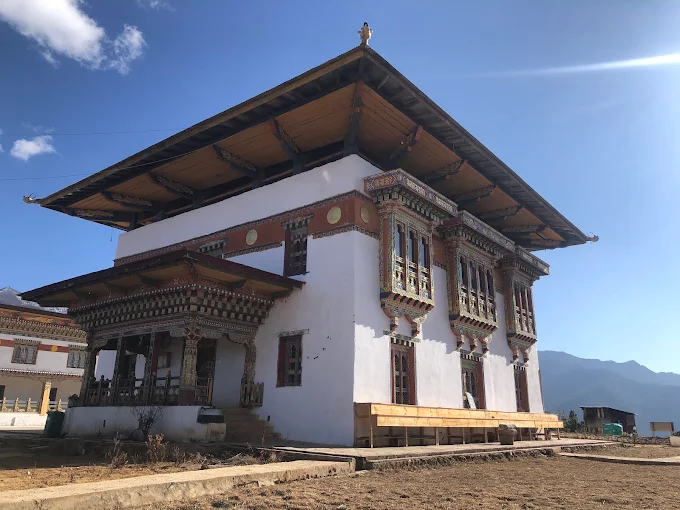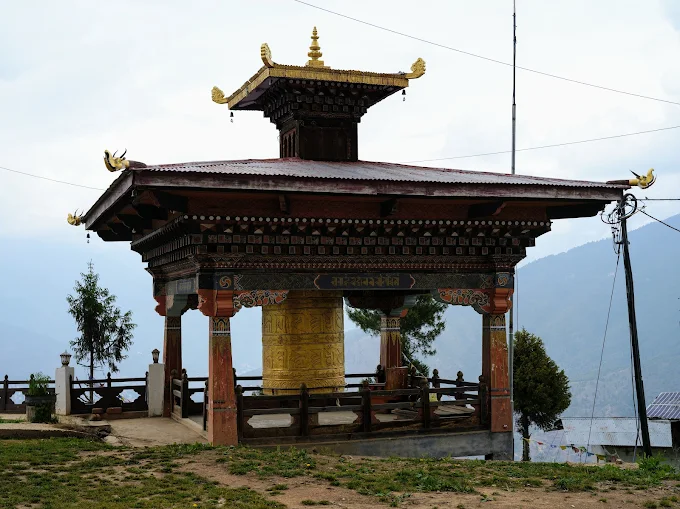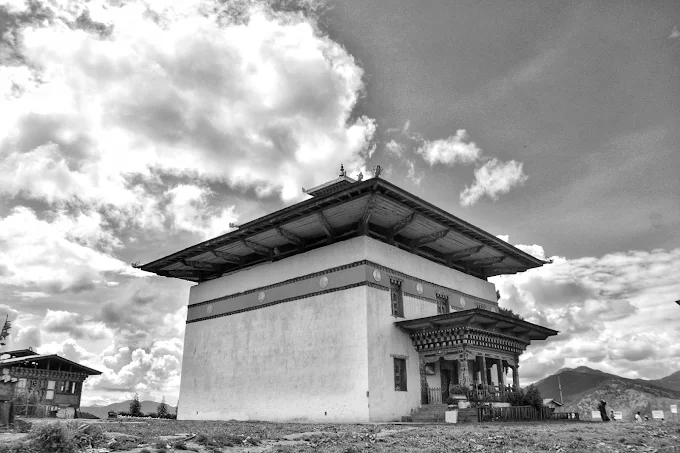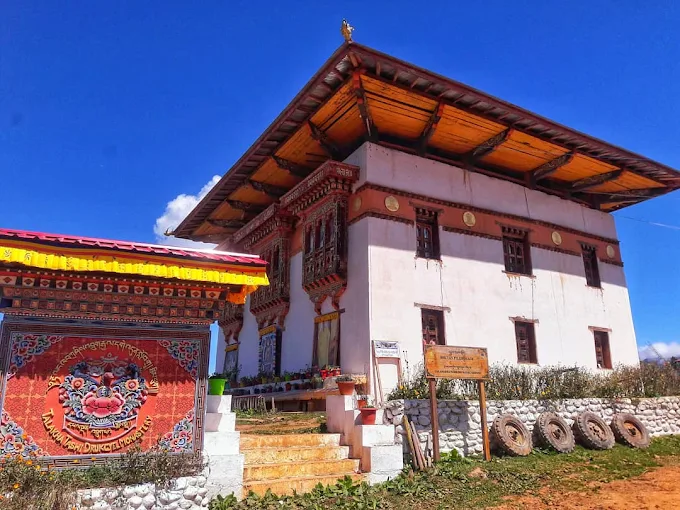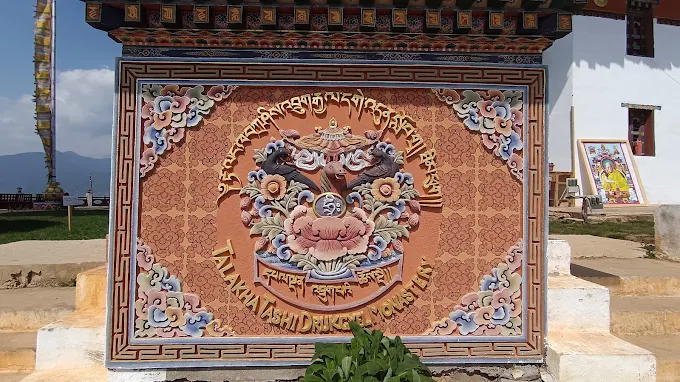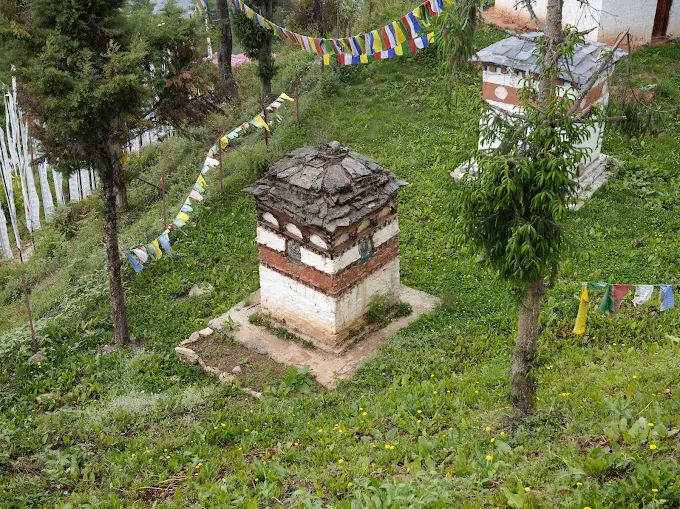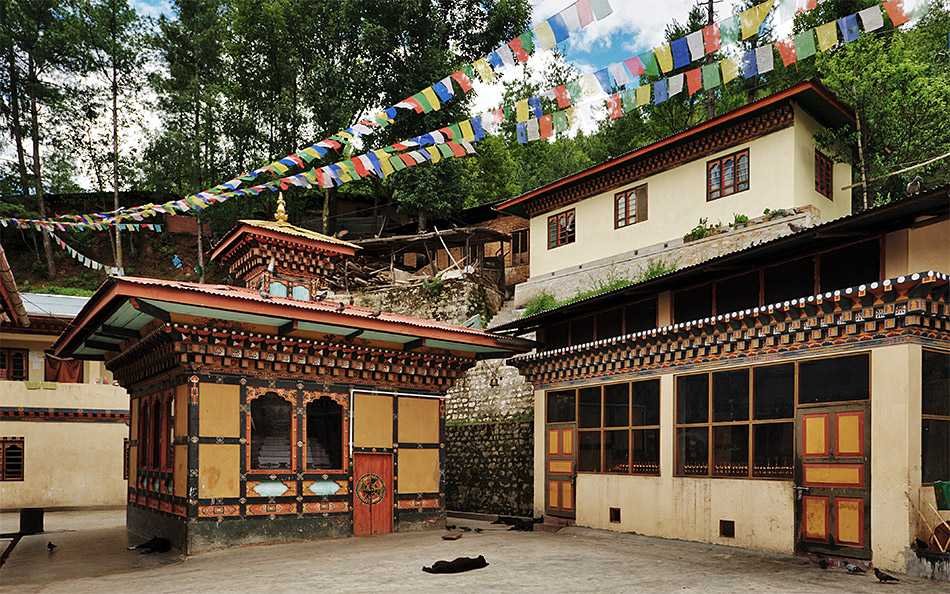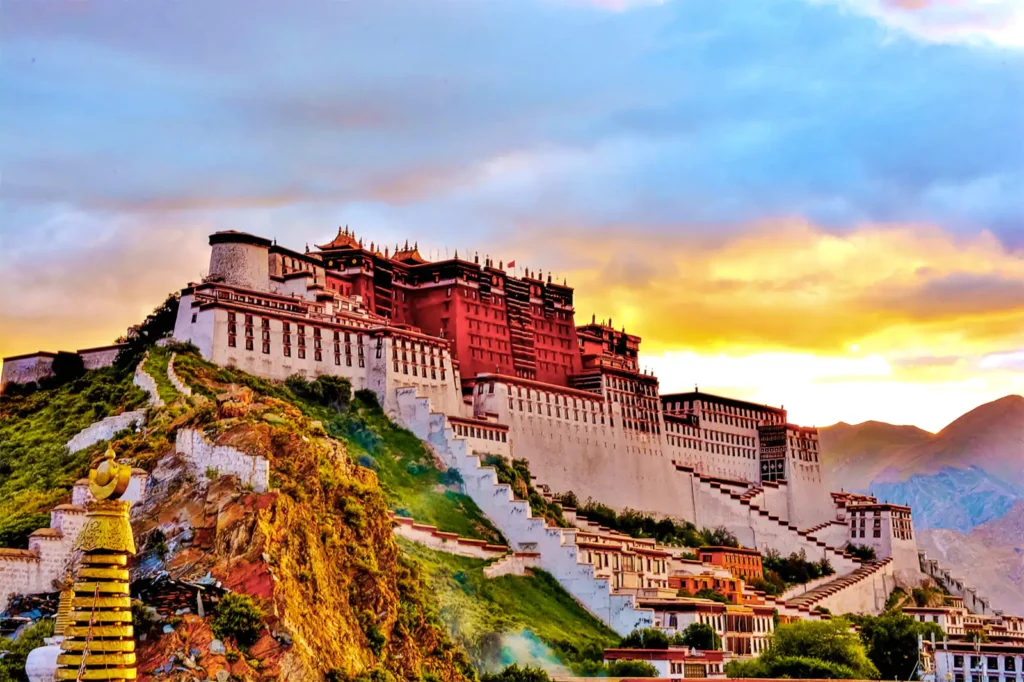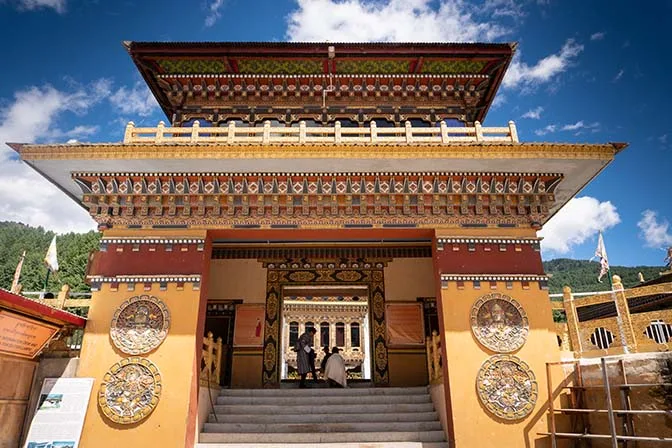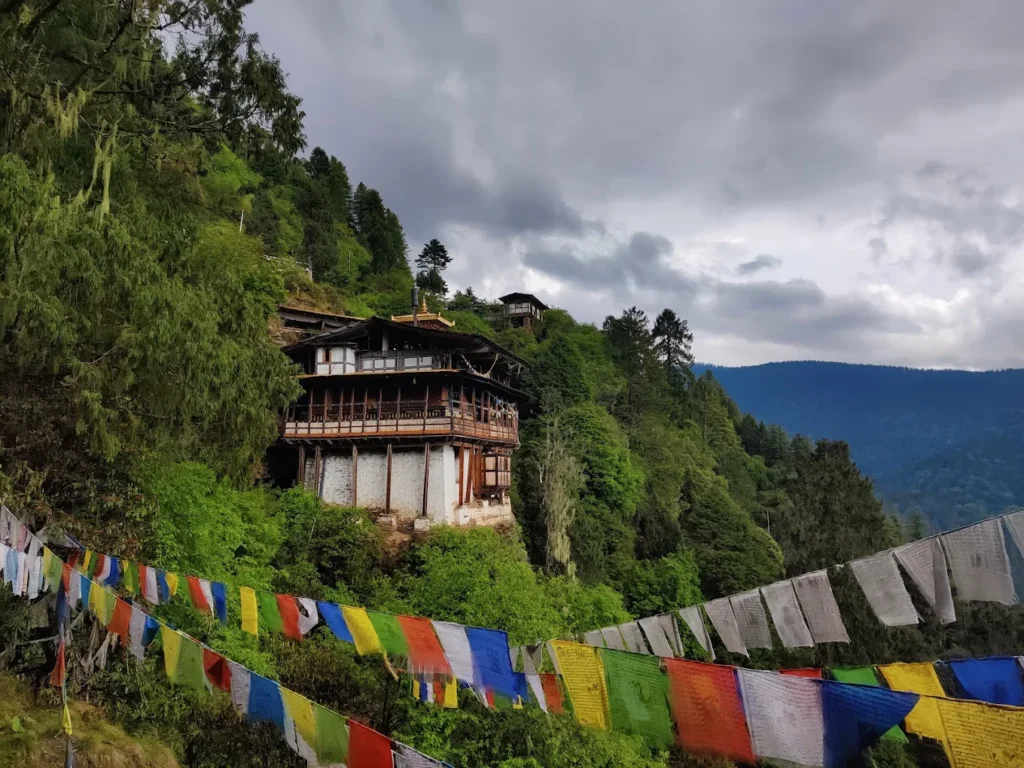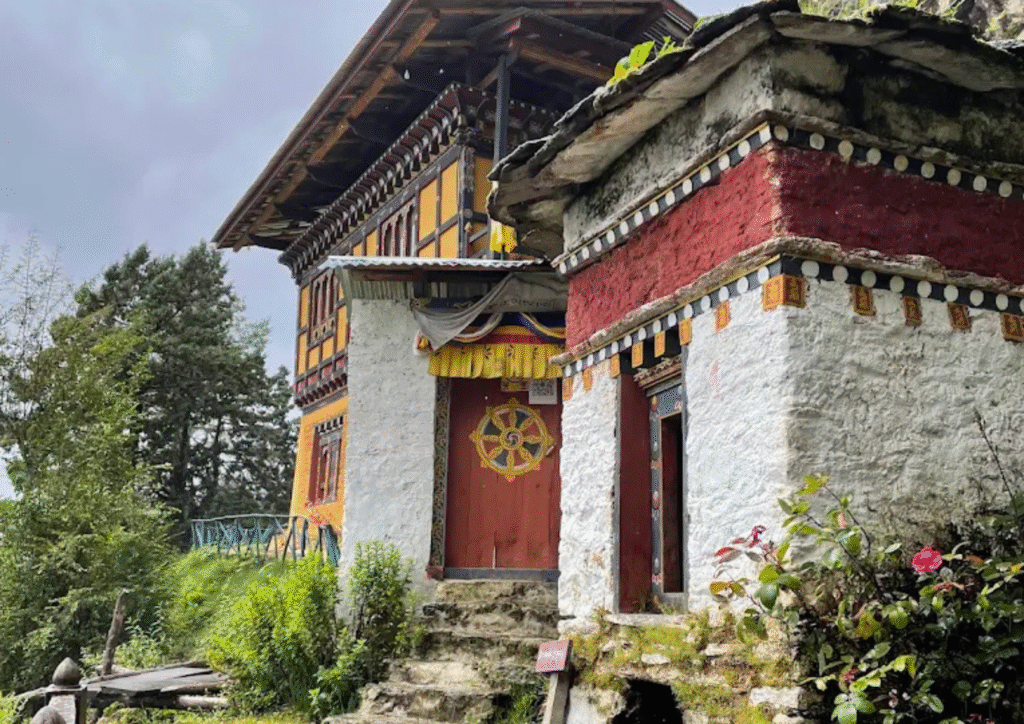Talakha Tashi Drukgyel Monastery: The Serene Overlook of Thimphu’s Drukpa Kagyu Legacy
Perched majestically at an elevation of 3,100 meters on a ridge overlooking the sprawling Thimphu Valley, Talakha Tashi Drukgyel Monastery emerges from the morning mist, its stone walls catching the golden hues of dawn. Within the sacred main temple (lhakhang), monks chant the Om Mani Padme Hum mantra, their voices resonating around a statue of Zhabdrung Ngawang Namgyal, a central figure in Bhutan’s spiritual history. Known also as Talakha Goenpa, this Drukpa Kagyu sanctuary, with its origins traced to the 15th century or earlier, offers a tranquil retreat framed by thick pine forests. The air carries the scent of juniper incense, lit to honor the monastery’s heritage, while prayer flags flutter against the Himalayan breeze, blessing the valley below. From its elevated vantage point, the panoramic view of Thimphu, including landmarks like Simtokha Dzong, stretches out, connecting the monastery to Bhutan’s spiritual heart. This sacred haven invites travelers, seekers, and scholars to ascend its trails and immerse themselves in the peaceful essence of Drukpa Kagyu devotion.
Whispers of Tranquility: Overview and Significance
Introduction to Talakha Tashi Drukgyel Monastery
Talakha Tashi Drukgyel Monastery, situated on a ridge in Thimphu Dzongkhag, Bhutan, at approximately 3,100 meters, stands as a revered Drukpa Kagyu sanctuary, celebrated for its serene overlook of the Thimphu Valley and its historical significance. A hike or drive from Chamgang reveals a tranquil retreat where the rustle of pine forests and distant valley hums create a peaceful ambiance. Also known as Talakha Goenpa, it embodies Bhutan’s spiritual heritage, blending meditation with the natural beauty of its elevated location. A cultural and spiritual gem, the monastery weaves history, solitude, and Himalayan reverence into a timeless refuge.
Historical Journey
Talakha Tashi Drukgyel Monastery’s history is linked to the 15th century or earlier, with records suggesting its establishment by Lama Shakya Gyaltsen, a teacher associated with Azhi Nangsa Yobum. The current structure, remodeled or rebuilt in the 1830s under the 25th Je Khenpo, Sherab Gyaltsen, reflects its enduring legacy. Another account attributes its founding to Ngawang Chogyal, the 15th abbot of Ralung Monastery, though exact dates remain uncertain due to discrepancies with earlier figures. Expanded over time by local communities, the monastery has been preserved as a place of pilgrimage and meditation, its stone walls standing resilient against the elements.
Cultural Significance
- Drukpa Kagyu Devotion: Rooted in the Drukpa Kagyu lineage, the monastery venerates Zhabdrung Ngawang Namgyal and other key figures, emphasizing meditation and spiritual reflection.
- Bhutanese Heritage: A spiritual retreat, it preserves rituals like mantra recitation, reflecting national identity and tranquility.
- Panoramic Legacy: Its elevated position offers a unique view, enhancing its role as a meditative site.
- Regional Influence: Pilgrimages draw devotees from Thimphu and nearby areas, fostering community bonds.
Unique Legacy
- Elevated Overlook: At 3,100 meters, its panoramic view of Thimphu distinguishes it among Bhutan’s monasteries.
- Historical Roots: Linked to Lama Shakya Gyaltsen, it reflects early Drukpa Kagyu influence.
- Architectural Endurance: The 1830s remodel showcases Bhutanese resilience.
- Cultural Symbol: Its solitude mirrors Bhutan’s spiritual retreat tradition.
Community and Global Impact
- Local Devotion: The monastery hosts retreats and picnics, strengthening Thimphu’s Buddhist ties.
- Pilgrimage Hub: Visitors are drawn by its peaceful setting and valley views.
- Global Appeal: International hikers and meditators seek its serene ambiance.
- Cultural Dialogue: Shared rituals unite Bhutanese and global visitors, fostering understanding.
Modern Relevance
- Spiritual Retreat: Talakha offers a haven for mindfulness away from urban life.
- Cultural Preservation: It safeguards Drukpa Kagyu practices, ensuring Bhutan’s heritage thrives.
- Natural Harmony: Its setting inspires ecological and spiritual reflection.
Historical Anecdotes
- Lama Shakya’s Founding: His 15th-century role shaped the monastery’s origins.
- Je Khenpo’s Remodel: The 1830s reconstruction by Sherab Gyaltsen marked its revival.
- Picnic Tradition: Local tales of outdoor gatherings enhance its appeal.
Social Role
- Community Hub: Retreats and picnics unite Thimphu’s Buddhists.
- Meditative Center: Monks guide pilgrims in spiritual practice.
- Charitable Spirit: Communal gatherings reflect Drukpa Kagyu compassion.
Artistic Influence
- Thangka Art: Murals of Zhabdrung inspire Bhutanese artists.
- Cultural Icon: The valley view graces local imagery.
- Festival Art: Simple decorations showcase Bhutanese craftsmanship.
Talakha Tashi Drukgyel Monastery’s ridge-top perch, where Lama Shakya Gyaltsen once meditated, weaves a narrative of devotion and solitude that defines Bhutan’s Drukpa Kagyu legacy. From its 15th-century origins to its role as a peaceful retreat, the monastery’s history resonates with the tranquility of Thimphu Valley, uniting monks and pilgrims. Its sacred halls and scenic trails set the stage for an architectural tapestry that mirrors its Himalayan soul. As we delve into its physical and spiritual features, Talakha’s design reveals how its elevated beauty nurtures profound meditation and reflection.
Crafted by the Ridge: Architectural and Spiritual Features
Iconic Design
Talakha Tashi Drukgyel Monastery’s architecture blends Drukpa Kagyu simplicity with its ridge-top setting, creating a sanctuary that harmonizes with Thimphu’s forested landscape. Whitewashed stone walls and wooden roofs, adorned with prayer flags, rise from the 3,100-meter elevation, reflecting Buddhist serenity. The two-storied layout, centered on the main lhakhang, prioritizes meditative function, with courtyards fostering community. Its perch above the Thimphu Valley, offering panoramic views, amplifies its sacred resonance, tying the monastery to Bhutan’s Himalayan ethos.
Key Structures
- Main Lhakhang: The spiritual core, housing Zhabdrung’s statue, remodeled in the 1830s.
- Upper Chamber: A second story with Dhuesum Sangay statues, built for meditation.
- Chorten Courtyard: Stone stupas honor lamas, surrounded by prayer wheels.
- Kanjur Room: A chamber with scriptures on Dheysho, a single Daphne tree product.
- Prayer Flag Poles: Tall structures strung with flags, dotting the ridge.
- Picnic Shelter: A recent addition behind the temple, using construction materials.
Worshipped Statues
- Zhabdrung Ngawang Namgyal: A bronze statue, symbolizing unity, radiates spiritual authority.
- Dhuesum Sangay: Three statues (past, present, future Buddhas) in the upper chamber, carved from wood.
- Chenrezig (Avalokitesvara): A white stone statue, representing compassion, flanks the altar.
- Spiritual Role: Monks offer butter lamps to Zhabdrung, seeking guidance and peace.
Materials and Techniques
- Construction: Local stone and timber, joined with Bhutanese methods, ensure durability.
- Artistry: Simple murals and wooden carvings, crafted by Thimphu artisans, reflect Drukpa Kagyu style.
- Cultural Essence: The design prioritizes meditative austerity, distinct from dzong complexity.
Signature Elements
- Panoramic View: The 3,100-meter perch offers vistas of Thimphu, a unique feature.
- Chorten Cluster: Stupas symbolize spiritual continuity.
- Prayer Flags: Fluttering flags carry blessings across the valley.
Lesser-Known Features
- Kanjur Scriptures: Written on Dheysho, a rare material, housed in a dedicated room.
- Hidden Niche: A small recess in the stupa, linked to meditation practices.
- Old Prayer Wheel: A weathered mani wheel, in use since the 19th century.
Preservation Efforts
- Remodel (1830s): Rebuilt by Sherab Gyaltsen, preserving original design.
- Challenges: Erosion and weather test stonework, requiring maintenance.
- Modern Additions: Picnic shelters enhance visitor experience.
Environmental Integration
- Ridge Harmony: The monastery’s design respects Thimphu’s pine ecosystem.
- Eco-Practices: Monks maintain trails and protect flora.
- Wildlife Haven: Birds nest nearby, enhancing serenity.
Artisan Narratives
- Mural Painters: Thimphu artists restored simple decorations, preserving art.
- Stone Masons: Local craftsmen rebuilt walls, blending tradition.
- Flag Weavers: Nuns crafted prayer flags, embedding blessings.
Symbolic Details
- Prayer Flags: Five colors balance elements, spreading dharma.
- Chortens: Represent the Buddha’s mind, guiding meditation.
- Statues: Reflect Drukpa Kagyu leadership and compassion.
Landscape Integration
- Ridge Perch: Enhances meditative focus with valley views.
- Thimphu Panorama: The cityscape mirrors inner peace.
- Pine Forests: Provide solitude and spiritual resonance.
Talakha Tashi Drukgyel Monastery’s stone lhakhangs and sacred courtyards, overlooking Thimphu Valley, are more than architectural marvels; they are sanctuaries for the Drukpa Kagyu practices that define its tranquil soul. The statue of Zhabdrung, illuminated by butter lamps, anchors rituals that connect monks to Bhutan’s spiritual lineage. These hallowed spaces, alive with chants and solitude, invite visitors to engage with the monastery’s living traditions. As we explore its rituals, Talakha’s role as a meditative retreat comes to life, guiding devotees toward peace and reflection.
Rites of the Retreat: Rituals and Practices
Daily Sacred Rites
- Morning Chanting: Monks recite the Om Mani Padme Hum mantra at dawn, fostering compassion.
- Meditation Sessions: Silent meditation, held twice daily, centers on Mahamudra practices.
- Butter Lamp Offerings: Devotees light lamps before Zhabdrung, praying for guidance.
Unique Practices
- Ridge Meditation: Monks meditate in the upper chamber, honoring the valley view.
- Protective Puja: Rituals appease local spirits, seeking ridge stability.
- Signature Ritual: Offering juniper incense, tied to the monastery’s serene tradition.
Festival Traditions
- Talakha Tshechu (date unspecified): Cham dances and Zhabdrung offerings, held annually.
- Lhabab Duchen: Ceremonies honor the Buddha’s descent, with chorten circuits.
- Losar (Bhutanese New Year): Monks perform purification rites, blessing visitors.
- Statue Veneration: Zhabdrung’s statue is adorned with silk during festivals.
Visitor Engagement
- Accessible Rituals: Visitors can join chants or offer incense, guided by monks.
- Offerings: Butter lamps and prayer flags, available at the monastery, invite participation.
- Drukpa Etiquette: Bow before statues and maintain silence during meditation.
Spiritual Community Roles
- Monastics: Around 10–20 monks lead rituals and maintain the site.
- Lamas: Senior monks guide meditation and pujas.
- Lay Devotees: Thimphu villagers maintain trails and offer supplies.
Interfaith Connections
- Syncretic Practices: Some blend Drukpa rites with Bon offerings, honoring local spirits.
- Outreach: Festivals welcome diverse faiths, fostering unity.
- Education: Monks share meditation practices with visitors.
Ritual Symbolism
- Butter Lamps: Represent wisdom illuminating peace.
- Juniper Incense: Symbolizes purification of the mind.
- Cham Dances: Enact spiritual harmony with nature.
Seasonal Variations
- Spring Rites: Vibrant with pine, ideal for Talakha Tshechu.
- Winter Retreats: Cold enhances ridge meditation focus.
- Monsoon Chants: Rain amplifies mantra resonance.
Monastic Life
- Daily Routine: Monks rise at 5:00 AM for chants, meditation, and maintenance.
- Community Service: Monks guide pilgrims and protect the site.
- Training Hub: Monks learn Drukpa Kagyu practices for spiritual depth.
Talakha Tashi Drukgyel Monastery’s rituals, from the Om Mani Padme Hum mantra to ridge meditations, breathe life into its elevated sanctuary, connecting devotees to the Drukpa Kagyu lineage. The monastery’s peaceful practices, rooted in Bhutan’s spiritual faith, invite visitors to engage with its tranquil heart, whether through chants or silent reflection. For travelers, these rites offer a glimpse into Thimphu’s sacred traditions, accessible within its forested grounds. As we turn to visitor information, Talakha’s ridge-top setting guides practical planning, ensuring a meaningful journey to this serene retreat.
Journey to the Ridge: Visitor Information
Navigating to Talakha Tashi Drukgyel Monastery
- Location: Thimphu Dzongkhag, 3,100 meters, accessible via a trail from Serbithang or a road from Chamgang.
- Landmarks: Near Royal Botanical Garden and Chamgang village, with Dzongkha and English signs.
- Routes: Hike from Serbithang (1–2 hours) or drive via Chamgang’s feeder road.
Address of Talakha Tashi Drukgyel Monastery
- Dzongkha: Talakha Tashi Drukgyel Goenpa, Thimphu Dzongkhag, Bhutan.
- English: Talakha Tashi Drukgyel Monastery, Thimphu District, Bhutan.
Visiting Hours and Etiquette
- Hours: Open daily, 6:00 AM–5:00 PM, with meditation sessions in the morning.
- Etiquette: Dress modestly, remove shoes before lhakhangs, and avoid disturbing rituals.
- Drukpa Custom: Offer butter lamps with both hands and bow to statues.
Transport Options
- By Foot: Hike from Serbithang (1–2 hours, moderate difficulty).
- By Vehicle: Drive via Chamgang’s rough road, requiring a four-wheeler.
- By Horse: Local guides offer horses, arranged at the trailhead.
Accessibility and Safety
- Mobility: Steep trails and rough roads may challenge those with mobility issues; no ramps available.
- Safety: Stable paths with guideposts; carry water and layers for altitude.
- Tips: Wear sturdy hiking boots and bring a packed lunch.
Amenities and Surroundings
- Facilities: Basic restrooms and a picnic shelter behind the temple; no shops on-site.
- Nearby: Simtokha Dzong and Thadrak Goemba, within 10–15 km, offer cultural experiences.
- Dining: Picnic areas encourage packed meals, with options in Thimphu.
Immersive Visitor Tips
- Best Timing: Early morning hikes offer clear views and monk chants.
- Sensory Moments: Inhale pine-scented air and hear valley echoes.
- Statue Connection: Offer butter lamps to Zhabdrung and meditate briefly.
- Picnic Planning: Bring a packed lunch for the outdoor shelter.
Nearby Cultural Experiences
- Simtokha Dzong: A historic fortress, 10 km away, blends spirituality and history.
- Thadrak Goemba: A nearby meditation site, 12 km away, offers solitude.
- Buddha Point: A panoramic viewpoint, 15 km away, features the giant Buddha statue.
Photography Tips
- Best Angles: Capture the lhakhang at sunrise for golden light.
- Respectful Shots: Avoid photographing monks during meditation without permission.
- Scenic Views: The Thimphu Valley offers stunning panoramas.
- Equipment: A lightweight camera suits the trek.
The ascent to Talakha Tashi Drukgyel Monastery, guided by Thimphu’s forested trails, is a pilgrimage that blends physical effort with spiritual discovery, inviting visitors to engage with its Drukpa Kagyu traditions. The monastery’s lhakhangs and courtyards, vibrant with chants and solitude, offer a window into Bhutan’s sacred heart, where peace feels tangible. Beyond its elevated beauty, Talakha’s deeper cultural and spiritual significance enriches the experience, revealing the essence of Himalayan Buddhism. As we explore these insights, the monastery’s role as a beacon of tranquility and reflection comes into sharper focus, deepening our connection to its sacred legacy.
Insights of the Ridge: Cultural and Spiritual Reflections
Drukpa Kagyu Philosophy
Talakha Tashi Drukgyel Monastery embodies Drukpa Kagyu’s core: compassion and wisdom through meditation and solitude. Zhabdrung Ngawang Namgyal and Chenrezig inspire devotees to seek inner peace, reflected in chants and retreats. Mahamudra teachings emphasize direct realization, guiding monks toward enlightenment.
Environmental Spirituality
The monastery’s ridge-top perch ties it to Himalayan reverence for nature. The Thimphu Valley’s pines and distant city hum foster meditative calm, with offerings honoring local deities. The landscape invites reflection on harmony with the natural world.
Artistic Symbolism
Thangka murals depict Zhabdrung’s legacy, symbolizing spiritual leadership. Chortens represent the Buddha’s mind, while prayer flags balance elements. These elements weave Drukpa Kagyu ideals into the monastery’s aesthetic.
Community Resilience
Founded by Lama Shakya’s followers, Talakha reflects Bhutanese perseverance through time. Its remodel by Sherab Gyaltsen showcases collective faith, sustained by volunteer efforts, uniting Thimphu’s Buddhists.
Environmental Stewardship
The monastery’s slopes foster Buddhist environmental ethics. Monks protect trails and pine forests, ensuring balance. Visitors are urged to honor the ridge’s sanctity.
Meditative Practices
Drukpa Kagyu meditation, including Mahamudra, cultivates awareness. The lhakhang offers spaces for ridge retreats, guided by monks, amplifying inner peace.
Cultural Narratives
- Lama Shakya’s Legacy: His founding inspires devotion.
- Remodel Tales: Sherab Gyaltsen’s work links past and present.
- Picnic Lore: Outdoor gatherings carry local traditions.
Historical Context
- Early Foundations: Lama Shakya’s influence shaped Drukpa Kagyu identity.
- Je Khenpo Era: The 1830s remodel strengthened its role.
- Modern Continuity: Tranquility endures in Thimphu’s culture.
Reflecting on the Journey
Talakha Tashi Drukgyel Monastery, cradled on Thimphu’s sacred ridge, is a sanctuary where tranquility meets wisdom. Its lhakhangs and courtyards, alive with Zhabdrung’s legacy, embody Bhutan’s Drukpa Kagyu soul, inviting all to seek enlightenment. The monastery’s trails, worn by centuries of pilgrims, tell a story of resilience and devotion, rooted in Himalayan faith. Whether meditating before Chenrezig, enjoying the valley view, or tracing Bhutan’s meditative heritage, visitors find a space to reflect and connect. As you descend, the pine scent and prayer flags’ flutter linger, a reminder that peace is always within reach.
